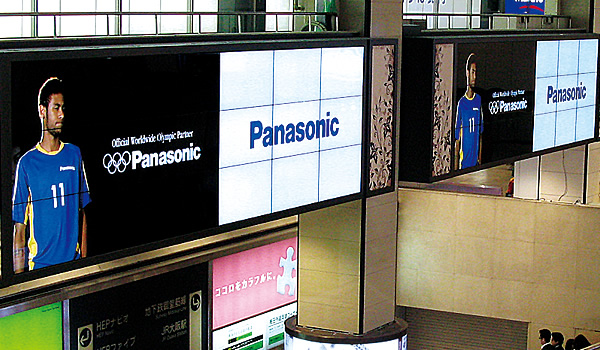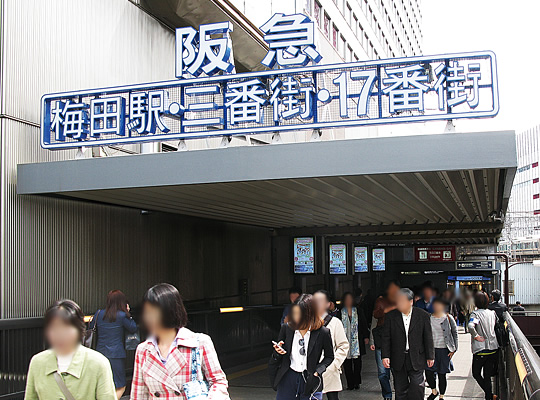

Installation Details
Signage Systems at the Gateway to "Kita" Osaka
Hankyu Corporation, a railway company that links the three major cities of Japan's Kansai region — Kyoto, Osaka and Kobe — conducted an extensive renewal construction of its Umeda Station in May 2012. As part of this, it installed two digital signage systems consisting of 42 Panasonic displays in total, with one called Umeda Twin Vision serving as an advertising medium near the station concourse, and the other at a 2nd Floor Connecting Bridge.

Umeda Twin Vision Comprises 2 Side-by-Side Systems, Each Approximately 300 inches in Screen Size
Until that time, two large, illuminated signboards had been installed at the station's central 1st floor concourse. However, because the production and replacement of the decorative film for these signboards were time-consuming and costly, it was difficult to update them frequently and the available ad frames were limited. As a result, the same content was displayed for a long time and their promotional effect gradually weakened. It was decided to carry out a comparative study for the introduction of a digital signage system that would offer flexible, efficient operation. Among the displays that were studied, Panasonic systems boasted the following advantages.
Sharp, Highly Visible Images
The direct LED backlight and IPS panel of our displays achieve 800 cd/m² of brightness and a high contrast of 1,400:1 (dynamic contrast of 500,000:1), which allows them to provide various content with sharp, crisp images.
Long-Term Operation
Because Panasonic displays have a long service life even when used constantly at a brightness of 800 cd/m², they offer major benefits for signage use.
Narrow Bezel Design
Of the displays that were selected for the comparative study, ours had the narrowest bezel, which meant that the joints between the displays were barely visible when configured into a multi-screen system. This helped to maintain the attractiveness of the advertising design.
Highly Appraised Signage Systems
In addition to the superiority of the displays, the Panasonic system is highly appraised for its functions, stability, and low running cost. Furthermore, the wide viewing angle is an important point. As a result, a multi-screen system based on the TH-55LFV50 was selected. A total of 36 screens were used to form two systems, each one with 6 displays mounted horizontally and 3 vertically.
2nd Floor Connecting Bridge with Dust-Resistant/Water-Resistant Displays Installed in a Semi-Outdoor Passageway
The connecting passageway leading to JR Osaka Station had previously used poster frames and signboards, but after considering a more persuasive medium and having seen a number of dust-resistant/water-resistant displays at an exhibition, the following advantages became clear.
- Images with 1,000-cd/m² of brightness were able to show sharp, crisp content even in a bright, semi-outdoor environment.
- The location definitely required water resistance, but since the displays themselves are water resistant, there is no need for a cabinet, which saves space.
Considering the above, 6 TH-47LFX6 displays were selected.

System Description
A Large Multi-Screen System Offering Various Display Patterns, with Content Managed and Stored in a Cloud Server
Umeda Twin Vision
Multi-screen systems with six 55-inch displays mounted horizontally and 3 vertically in a set with an STB and DVI distributor are mounted side-by-side. The 18 displays in each set are capable of operating as a single large-screen unit measuring about 7.3 m x 2.1 m (approximately 300 inches) or as two approximately 165-inch screens simultaneously displaying two types of content. The display control signal is transmitted from the STB via RS-232C, and an infrared receiver allows remote control operation. The received signals are relayed to each display in a daisy chain configuration.
2nd Floor Connecting Bridge
Six 47-inch displays are each vertically mounted. Since all of the displays show the same content, a DVI signal from a single STB is relayed by daisy chaining.
Both the Umeda Twin Vision and 2nd Floor Connecting Bridge use cloud-type digital signage systems. Advertising content provided by the client is stored in an externally mounted server. By simply setting up a broadcasting schedule over the Internet, the content is distributed by a cloud server to each STB, and displayed according to the schedule.


Hankyu Corporation
One of Kansai's Largest Private Railroads, This Major Terminal Serves 500,000 People or More Each Day
Hankyu Corporation operates one of the largest railway systems in the Kansai region, linking Osaka (Umeda) with Kobe, Takarazuka, and Kyoto. As a part of this network, Umeda Station serves an average of 500,000 passengers every day (weekdays). As its largest terminal, this station also connects with the Osaka Municipal Subway, JR, and Hanshin Railway. Surrounding the area is a variety of commercial facilities and office buildings operated by Hankyu Corporation or the Hankyu Group, including the Hankyu Department Store, Hankyu Sanbangai, and Hankyu Grand Building. This station is at the core of the "Kita" Osaka area.

Equipment installed
- Video Wall Display
TH-55LFV50 x 36 - Outdoor Display
TH-47LFX6 x 6


